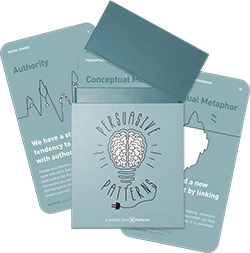Decoy Effect
Design Pattern
Problem summary
Create a new option that is easy to discard
Usage
- Use to make users pick one option over another
- Use to change what parameters users focus on to make a decision
- Use to make some options (target) more attractive than a competing option by adding a decoy option.
This card is part of the Persuasive Patterns printed card deck
The Persuasive Patterns Card Deck is a collection of 60 design patterns driven by psychology, presented in a manner easily referenced and used as a brainstorming tool.
Get your deck!Solution
- Target option should asymmetric dominate. In an ideal decoy situation, there are three choices available: Target (what you want people to choose), competitor, and decoy. To be effective, the decoy must be asymmetrically dominated by the target and the competitor. In other words, the target should rate better than the decoy on all parameters (better on both A and B), where the competitor is only better than the decoy on a few parameters (better on A, but worse on B).
- Make choice less overwhelming. The more options we have, the more difficulty we have making a decision (paradox of choice) and the more regret we have making the “wrong choice”. By manipulating what we focus on to make a decision and providing justification for our choices, the decoy effect can help us feel less anxiety from having too many options to choose from.
- Decoys act as a new reference point for loss. According to the theory of Loss Aversion, it is more unpleasant to loose $10 than it is pleasant to gain $10. Loss aversion causes us to direct more focus toward the disadvantages when making decision. What constitutes as a loss and a gain is not set in stone and is defined relative to some reference point why decoy options can partially function by manipulating where the reference point is, changing what is perceived as a loss and what is perceived as a gain.
Rationale
We tend to have a specific change in preference between two options when a third option is also presented. When the third option is asymmetric between the original two options, customer preference will lean toward the asymmetry. If the original two options are $5 and $10, then a third $9 option will make choice lean toward the $10 option. The decoy option is superior to the first option, but similar to the second.
Discussion
Decoys are a type of behavioral nudge, an unobtrusive and, to the user unconscious, type of intervention that can subconsciously alter the way we make decisions.
Decoys capitalize on a number of weaknesses of our decision making processes:
- they make it easier to rationalize our intuitive choices,
- they make us feel less overwhelmed by choice overload, and
- they prey upon our dislike of losing out.
The concept of asymmetric dominance was coined by Joel Huber, John Payne, and Chris Puto in 1982. They found that new products in the marketplace, rather than always cannabilizing on each other (similarity hypothesis), can help boost the popularity of the alternative that it is closest to (the target) and even boost the likelihood of choosing an option in the original market (regularity principle).
1 Huber, Payne & Puto (1982). Adding asymmetrically dominated alternatives: Violations of regularity and the similarity hypothesis. Journal of Consumer Research, 9(1), 90.
2 Hiebert, P. (2014, December 18). The paradox of choice, 10 years later. Pacific Standard.
3 Chernev, A., Böckenholt, U., & Goodman, J. (2015). Choice overload: A conceptual review and meta-analysis. Journal of Consumer Psychology, 25(2), 333-358.
4 Ariely, Dan (2009). Predictably Irrational: The Hidden Forces that Shape Our Decisions. HarperCollins. Chapter 1.
5 Why do we feel more strongly about one option after a third one is added? The Decoy Effect, explained.
6 Bateman, I. J., Munro, A., & Poe, G. L. (2008). Decoy effects in choice experiments and contingent valuation: Asymmetric dominance. Land Economics, 84(1), 115-127.
7 Simonson, I. (1989). Choice based on reasons: The case of attraction and compromise effects. Journal of Consumer Research, 16(2), 158-174.
8 Slaughter, J. E., Bagger, J., & Li, A. (2006). Context effects on group-based employee selection decisions. Organizational Behavior and Human Decision Processes, 100(1), 47-59.
9 Stoffel, S. T., Yang, J., Vlaev, I., & von Wagner, C. (2019). Testing the decoy effect to increase interest in colorectal cancer screening. PLOS ONE, 14(3), e0213668.
10 The Decoy Effect at Learning Loop
User Interface Design Patterns
- Forms
- Explaining the process
- Community driven
- Tabs
- Jumping in hierarchy
- Menus
- Content
- Gestures
- Tables
- Formatting data
- Images
- Search
- Reputation
- Social interactions
- Shopping
- Increasing frequency
- Guidance
- Registration
Persuasive Design Patterns
- Loss Aversion
- Other cognitive biases
- Scarcity
- Gameplay design
- Fundamentals of rewards
- Gameplay rewards


